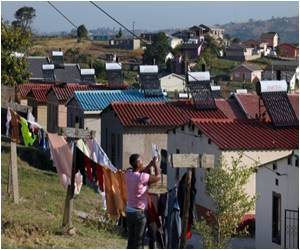Solar panels not only provide cleaner energy, but they also cool your house, or your workplace, according to researchers led by Prof. Jan Kleissl, UC San Diego Jacobs School of Engineering.

“Talk about positive side-effects,” said Kleissl.
As solar panels sprout on an increasing number of residential and commercial roofs, it becomes more important to consider their impact on buildings’ total energy costs, Kleissl said. His team determined that the amount saved on cooling the building amounted to getting a 5 percent discount on the solar panels’ price, over the panels’ lifetime. Or to put it another way, savings in cooling costs amounted to selling 5 percent more solar energy to the grid than the panels are actually producing— for the building researchers studied.
Data for the study was gathered over three days in April on the roof of the Powell Structural Systems Laboratory at the Jacobs School of Engineering with a thermal infrared camera. The building is equipped with tilted solar panels and solar panels that are flush with the roof. Some portions of the roof are not covered by panels.
The panels essentially act as roof shades, said Anthony Dominguez, the graduate student lead on the project. Rather than the sun beating down onto the roof, which causes heat to be pushed through the roof and inside the ceiling of the building, photovoltaic panels take the solar beating. Then much of the heat is removed by wind blowing between the panels and the roof. The benefits are greater if there is an open gap where air can circulate between the building and the solar panel, so tilted panels provide more cooling. Also, the more efficient the solar panels, the bigger the cooling effect, said Kleissl. For the building researchers analyzed, the panels reduced the amount of heat reaching the roof by about 38 percent. Although the measurements took place over a limited period of time, Kleissl said he is confident his team developed a model that allows them to extrapolate their findings to predict cooling effects throughout the year.
For example, in winter, the panels would keep the sun from heating up the building. But at night, they would also keep in whatever heat accumulated inside. For an area like San Diego, the two effects essentially cancel each other out, Kleissl said.
“There are more efficient ways to passively cool buildings, such as reflective roof membranes,” said Kleissl. “But, if you are considering installing solar photovoltaic, depending on your roof thermal properties, you can expect a large reduction in the amount of energy you use to cool your residence or business.”
Source-Medindia
 MEDINDIA
MEDINDIA

 Email
Email




